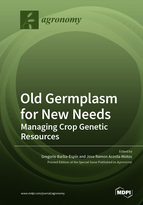Old Germplasm for New Needs: Managing Crop Genetic Resources
A special issue of Agronomy (ISSN 2073-4395). This special issue belongs to the section "Crop Breeding and Genetics".
Deadline for manuscript submissions: closed (1 November 2021) | Viewed by 37953
Special Issue Editors
Interests: plant biotechnology and breeding; crop management; plant biotechnology; antioxidant metabolism, proteomics, molecular biology in numerous plant species
Special Issues, Collections and Topics in MDPI journals
2. Group of Fruit Tree Biotechnology, Department of Plant Breeding, CEBAS-CSIC, 30100 Murcia, Spain
Interests: plant physiology; stress physiology; abiotic stress; salinity; antioxidative metabolism; water saving strategies; postharvest technology; ornamental plants; rice; fruit trees
Special Issues, Collections and Topics in MDPI journals
Special Issue Information
Dear Colleagues,
The impacts of climate change on crop production are already a reality in Europe and the rest of the world. In order to mitigate these impacts, access to unexploited genetic crop diversity for the production of new varieties that can thrive in more extreme environmental conditions is of prime importance. Herein, genetic diversity should provide the raw material for breeding and plant improvement. Despite the vast pool of resources that exist, much of the germplasm richness found in gene banks is poorly documented. To overcome the barriers between germplasm conservation and use, a complete evaluation is necessary to find out the useful diversity they contain.
This Special Issue will focus on “Old Germplasm for New Needs: Managing Crop Genetic Resources”. We welcome novel research, reviews, and opinion pieces covering all related topics including germplasm evaluation, crop genetics and improvement, novel crops, phenotyping, physiological responses of inbred lines, management solutions, modeling, case studies from the field, and policy positions.
Dr. Gregorio Barba-Espín
Dr. Jose Ramon Acosta-Motos
Guest Editors
Manuscript Submission Information
Manuscripts should be submitted online at www.mdpi.com by registering and logging in to this website. Once you are registered, click here to go to the submission form. Manuscripts can be submitted until the deadline. All submissions that pass pre-check are peer-reviewed. Accepted papers will be published continuously in the journal (as soon as accepted) and will be listed together on the special issue website. Research articles, review articles as well as short communications are invited. For planned papers, a title and short abstract (about 100 words) can be sent to the Editorial Office for announcement on this website.
Submitted manuscripts should not have been published previously, nor be under consideration for publication elsewhere (except conference proceedings papers). All manuscripts are thoroughly refereed through a single-blind peer-review process. A guide for authors and other relevant information for submission of manuscripts is available on the Instructions for Authors page. Agronomy is an international peer-reviewed open access monthly journal published by MDPI.
Please visit the Instructions for Authors page before submitting a manuscript. The Article Processing Charge (APC) for publication in this open access journal is 2600 CHF (Swiss Francs). Submitted papers should be well formatted and use good English. Authors may use MDPI's English editing service prior to publication or during author revisions.
Keywords
- Crop germplasm
- Crop genetics
- Crop phenotype
- Food security
- Crop stress tolerance
- Crop physiology







